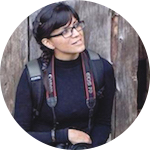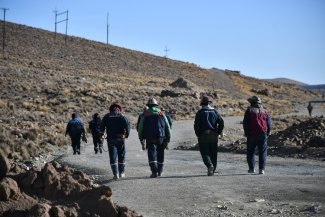In mid-November 2016 the 12th “Looking for Life on the Path of Death” caravan set out, with 43 Central American mothers taking part. For the third year in a row, they were joined by the fathers. They are all looking for migrant children whom they have lost trace of somewhere in Mexico, and they are doing so with photos of the disappeared hanging around their necks, or carried in their hands.
Together with the photos of their own children are those of hundreds of other migrants, representing the families who could not join the caravan. This time, the parents crossed 11 Mexican states (Chiapas, Tabasco and Veracruz amongst others) that are part of the migratory route, searching boarding houses, prisons and high risk areas (owing to the presence of organised crime and the absence of the authorities).
The caravan, made up of mothers and fathers from El Salvador, Honduras, Nicaragua and Guatemala, is protesting at the disappearance of thousands of Central Americans in Mexico, and at the lack of migration policies to guarantee safe passage for migrants (to the US).
“Our children leave to go the United States in search of work and to flee the violence. We know of authorities who beat the migrants on their journey; in addition to organised crime, we are talking about authorised crime,” says Ana Zelaya, a Salvadoran woman who has spent 14 years looking for her son and 12 years taking part in the caravan.
Rubén Figueroa, the south-south east coordinator of the Mesoamerican Migrant Movement (MMM) which supports and is behind the organisation of the mothers’ caravan, notes that with the arrival of Donald Trump as President of the United States, “there will be more radicalisation and xenophobia [in Mexico], which will lead to even greater insecurity for migrants on the migratory route that has occurred ever since the Mexican government [of Enrique Peña Nieto] announced [in July 2014] the Southern Border Plan.”
The aim of the plan is to curb Central American migration, which passes through Mexico in order to reach the US, and therefore to control the criminal groups that take advantage of migration.
In the two and a half years that the plan has been implemented, however, human rights violations have increased, according to migrant defenders such as MMM. Another consequence of the plan is that now the migrants choose more remote routes, as well as not hesitating to climb onto the train known as ‘The Beast’, where they risk falling off or falling prey to organised crime.
The 12th journey of this caravan passed through forest regions and the Pacific coast, a route habitually used for smuggling drugs and other contraband, and more recently by migrants.

Central American mothers reach the frontier between Guatemala and Mexico.
Marching and chanting, meetings with the Mexican authorities, public prayers, displaying the photos of the disappeared in the places they have travelled through, and house to house inquiries, are all part of the parents’ agenda (lasting nearly three weeks) in their joint efforts to discover the whereabouts of their children.

The caravan of Central American mothers marches through Ciudad Cuauhtémoc, Frontera Comalapa, municipality (Chiapas, México).
Their aim: to find clues as to the whereabouts of their disappeared children, and to protest at the disappearance of hundreds of migrants and the lack of migratory policies to guarantee free and safe transit.

As part of their search and their protest, the Central American mothers distribute information leaflets in all the towns they visit.
Kata López, representative of the Guatemalan mothers, delivers flyers with information about the mothers’ caravan and the Mesoamerican Migrant Movement. The aim is to ensure that as many Mexican citizens as possible know about their existence and that they can contact them if they have any useful information.

The parents of the missing migrants address the Mexican senate.
Central American mothers and fathers arrive at the Senate to demand legislation against forced disappearances and to stress again the urgency of creating a legal framework to guarantee the safe passage of people who decide to migrate, and to punish those responsible for the disappearance of migrants in Mexico.

“Where are they? Where are they? Our children, where are they”.
“Migrants are international workers,” chant the mothers and fathers while they walk through the streets and settlements close to the migratory routes. They always carry a picture of their offspring and of hundreds of other disappeared migrants. They ask the local residents if they have seen them, as every possible lead is essential.

The train tracks at the Villa Chontalpa Sttion (in the Tabasco State) where migrants arrive to climb on the infamous goods train known as ’The Beast’ (which goes from southern Mexico to towns on the US border).
This is one of the most dangerous parts of the migration route: kidnappings, rapes and extortion are commonplace, but it doesn’t discourage the mothers who take the time to carry out their inquiries.

In Barra de San José (in the Villa Mazatán municipality, in Chiapas), in south-east Mexico, the mothers visit a section of the maritime route used by the migrants, a place that has claimed many victims.
But their hopes do not falter" the work of the Mesoamerican Migrant Movement has resulted in more than 269 children being reunited with their mothers and fathers. The message they leave behind, before returning home, is “Walls no, bridges yes,” in clear reference to the plans of the businessman turned US president.











